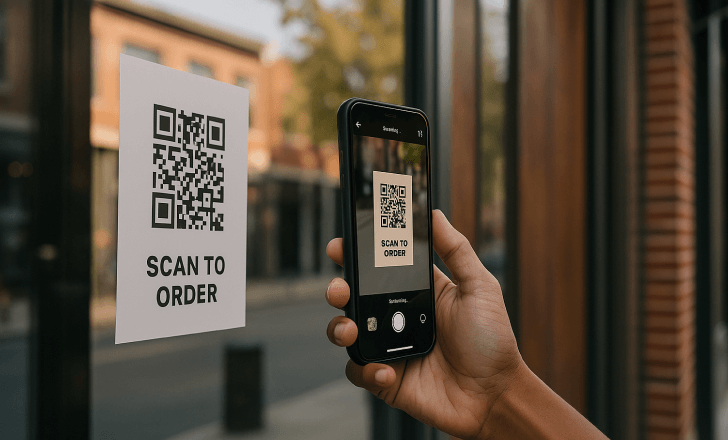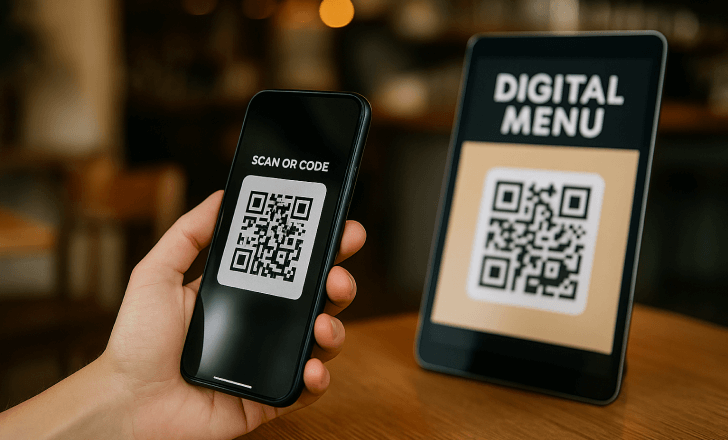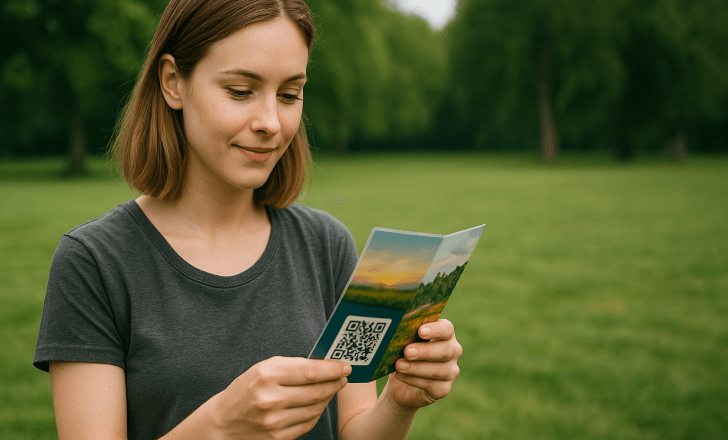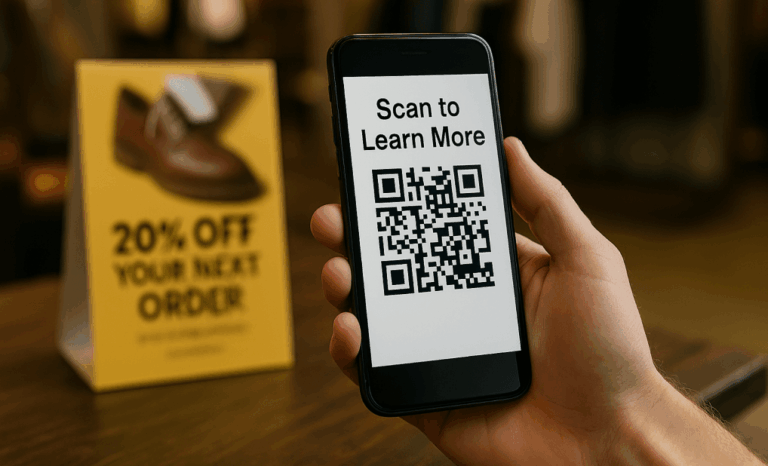QR codes are only as powerful as the action they inspire. You can create the most beautiful, custom dynamic QR code, print it on premium marketing material, and place it in a high-traffic area—but if the call to action falls flat, so will your scan rates. That’s why understanding how to craft a compelling CTA is just as important as the QR code itself.
In this article, we’ll walk through high-performing QR code call-to-action examples, unpack what makes them work, and explore strategies you can apply across your own QR code campaigns—from product packaging to print ads to digital menus and beyond.
Why your QR code’s CTA matters more than you think
A QR code without context is a missed opportunity. Whether it appears on a poster, flyer, product box, or screen, the call to action (CTA) attached to it is what turns a passive glance into an active scan.
The CTA is the bridge between curiosity and conversion. It tells your audience what they’ll get and why they should care—instantly. A well-crafted CTA helps you:
- Increase user engagement
- Drive traffic to a landing page or exclusive content
- Improve conversion rates
- Guide customers through your marketing funnel
In short, the CTA is your voice. And in mobile marketing, that voice has just a second to make an impact.
Real QR code call-to-action examples from successful campaigns
Let’s start with a few examples that have delivered results across industries. These action QR code CTAs stood out because they were clear, relevant, and matched the user’s intent.
1. “Scan to unlock 20% off your next order”
Used in: Retail packaging, thank-you inserts, store windows
Why it works: This CTA offers immediate, tangible value. It combines urgency (“your next order”) with a reward (“20% off”)—a proven formula in QR code marketing.
2. “See how it works in 3D”
Used in: Product packaging, furniture catalogs, AR marketing
Why it works: This line invites users to visualize the product through immersive content. It’s especially effective with dynamic QR codes linking to real-time 3D visualizations.
3. “Get your free guide”
Used in: Blog post footers, SaaS brochures, educational content
Why it works: It plays on the appeal of no-cost resources. Paired with a lead form, this CTA often fuels lead generation without sounding salesy.
4. “Join the VIP list”
Used in: Events, luxury packaging, digital business cards
Why it works: This is about status and exclusivity. When placed on a custom QR code, it signals that scanning gives access to something not everyone has.
What makes a QR code CTA compelling?
Behind every compelling CTA is a clear understanding of the target audience and what motivates them. The best QR code CTAs:
- Use concise language that respects attention spans
- Speak directly to a benefit (“Watch the demo,” “Claim your reward”)
- Include action verbs (“Scan,” “Discover,” “Unlock”)
- Avoid vague phrases like “Click here” or “More info”
Your CTA should also align with the visual design of your QR code. A well-designed QR code with brand colors and a readable frame reinforces trust and encourages users to scan.
Where should you place your CTA in relation to the QR code?
Placement isn’t just cosmetic—it affects usability. Here are some best practices:
- Above or beside the QR code: Puts the CTA in a natural reading flow before the scan.
- Integrated within the design: With custom QR codes, you can use branded frames or shapes that include the CTA inside the code’s appearance.
- As part of a sign-off: On product packaging or virtual events, try pairing your CTA with a signature phrase or brand tone for consistency.
Avoid burying your CTA in fine print or separating it from the QR code. If users don’t immediately see what they’ll get from scanning, they won’t do it.

QR code CTAs across different industries
Not every call to action works for every audience. Your QR code strategy should adapt to your market, the medium, and the value you’re offering. Let’s look at how different industries craft their CTAs to drive real results.
Retail and packaging: “Scan for product care tips”
QR codes on packaging aren’t just for links—they’re for trust. A CTA like “Scan for care instructions” helps reduce returns, improve satisfaction, and position your brand as helpful. Bonus: It’s a smart way to offer multilingual content without cluttering the packaging.

Food and beverage: “Explore our full menu”
From cafés in South Korea to food trucks in the U.S., digital menus powered by QR codes are now standard. A clear CTA like this one replaces bulky menus and speeds up ordering. It’s mobile-friendly, saves printing costs, and boosts upsell opportunities with visual content.

Events and entertainment: “Save your seat now”
Whether you’re running a virtual event or a live concert, QR code marketing makes registration seamless. This type of code call to action appears on event posters, social stories, and ticket confirmations—turning a static promotion into a real-time funnel.
Real estate: “Take a 360° virtual tour”
Dynamic QR codes placed on window signs or flyers help real estate professionals show more than a static photo. A CTA like this drives qualified leads to interactive content—without needing a sales rep on site.
Education and nonprofits: “Access free resources”
For organizations sharing educational content, a CTA that leads to toolkits or downloads works well. You can create a QR code that leads directly to PDFs, video lessons, or sign-up forms for newsletters. It’s direct, valuable, and fits into your digital marketing goals.

How to print QR codes without losing their CTA power
QR codes only work if they can be scanned—and read. But they only convert if the call to action is clear and visible. Here’s how to keep both intact in your printed materials.
Choose the right size
Too small and the code can’t be scanned. Too large and it dominates your layout. The sweet spot? At least 2 x 2 cm for short distances, larger if the user will scan from afar (like on a billboard or a QR code stand).

Maintain contrast and quiet zones
Use high contrast between the code and its background, and keep the surrounding “quiet zone” (the white space around the code) free of clutter. This ensures the code is readable and reinforces your brand’s visual clarity.
Position the CTA with intention
On flyers, put the CTA right above or within the QR code frame. On product packaging, pair it with a short graphic or icon that suggests interaction (like a phone or a tap symbol). The CTA should not be an afterthought—it should be designed as part of the code’s function.
Digital vs printed CTAs: What changes?
While the core message stays the same, the environment changes everything. Here’s what to keep in mind when adapting your call to action for screens versus print:
In digital formats (ads, social media, email)
- CTAs should be even shorter—think 3–5 words.
- Assume the user is already online and ready to act.
- Reinforce immediacy: “Scan now to download,” “Watch live.”
In printed formats (posters, packaging, brochures)
- Add context if needed: “Scan this code with your phone.”
- Avoid passive or vague language.
- Consider pairing the CTA with a benefit or preview: “Scan for full recipe.”
Remember: You’re not just creating a QR code. You’re creating a code with a call—a mini-conversation in motion.
What tools help you create strong QR code CTAs?
Creating QR code CTAs isn’t just about clever copy. You also need the right tools to design, track, and manage them effectively.
A good QR code generator will let you:
- Customize your code’s appearance with colors, logos, and shapes
- Choose between static and dynamic QR codes
- Add a CTA directly within the design (e.g., in the code frame)
- Track scans and user interaction for performance insights
Platforms like QR Code KIT allow marketers to create QR codes that reflect their brand and link to dynamic content that evolves over time.

How can dynamic QR codes improve your CTA performance?
Unlike static codes, dynamic QR codes allow you to change the destination URL or landing page without reprinting the code. That means you can:
- A/B test different calls to action
- Update promotions based on season or campaign
- Adapt messaging based on user behavior or feedback
For example, if your CTA is “Get your gift,” you can redirect the link to a new offer once the first one expires. Or, for multilingual campaigns, the CTA “Scan to explore” can lead to different versions based on the user’s language or location.
This flexibility is key in long-running marketing campaigns or on packaging that might stay on shelves for months.
Are there bad QR code CTAs? What should you avoid?
Absolutely. Even well-designed QR codes can underperform if the CTA is weak or misleading. Here are common mistakes:
- Vague CTAs: “Click here” or “Scan now” without telling users what for.
- Too much copy: If your CTA is a full sentence with disclaimers, it’s too long.
- No clear value: If there’s no reason to scan, people won’t.
- Mismatch between CTA and landing page: If the CTA says “See our video” but leads to a signup form, trust erodes instantly.
Stick to concise language, clear value propositions, and a matching destination. Your QR code campaign is only as strong as its weakest link.
What are the best call to action examples for increasing engagement?
A few tried-and-true CTA QR code phrases that continue to convert include:
- “Get instant access”
- “Claim your reward”
- “Scan to watch now”
- “Join the challenge”
- “Reveal your surprise”
Each of these encourages users to act and promises a benefit. But don’t just copy—test your CTAs with your target audience. The best call to action is the one that fits your tone, your product, and your user’s moment.

How do I measure if my QR code CTA is working?
If you’re using dynamic QR codes, you can track:
- Number of scans
- Time of day
- User location
- Device type
- Conversion actions (clicks, sign-ups, purchases)
Pair this data with A/B testing: try two CTAs, measure the difference in scan rates and conversions, and let the results guide your next marketing efforts.

What’s the future of QR code CTAs?
Expect QR code CTAs to become more personalized, more adaptive, and more embedded in interactive experiences. With the rise of smart packaging, NFC technology, and augmented reality, the humble QR code is evolving fast.
But one thing remains constant: a clear, well-crafted CTA is your best shot at turning a scan into something meaningful.
